Spotswood Custom Computer Cases
by Derek Wilson on August 27, 2008 12:00 AM EST- Posted in
- Cases/Cooling/PSUs
Installing a System
Working with the largest box (err… cylinder) that Spotswood makes, we expected to have a lot of room to work inside the case. This is true to some extent. There is actually plenty of room for internally mounting radiators for water-cooling systems. However, the extra space doesn't really do as much for ease of install and system access as we would normally expect from a large case. Don't look for anything highly modular, and while there are some thumbscrews, most of the work will be done with a variety of hex screws (the kit actually does come with tools, but you might need to supply your own wrench or pliers for holding some of the nuts at the back of some screws).
This case is not for the faint of heart. The two types of people we would recommend taking on the challenge are those with a lot of experience fighting cases (who have built a lot of PCs) or people who just like building stuff in general (and are comfortable improvising a solution if need be). If you're looking for a quick PC build, you'll want something else - but then you're not going to get a "drum" case, of course.
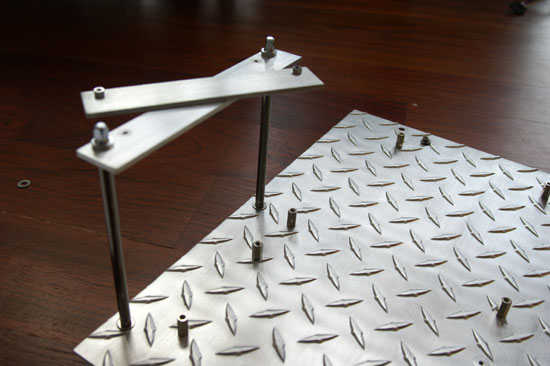
After removing the side panels, we remove the motherboard tray. Rather than having individual screws for each expansion card, it has two flat pieces of metal that sandwich the mounting brackets for the cards. This is pretty straightforward.
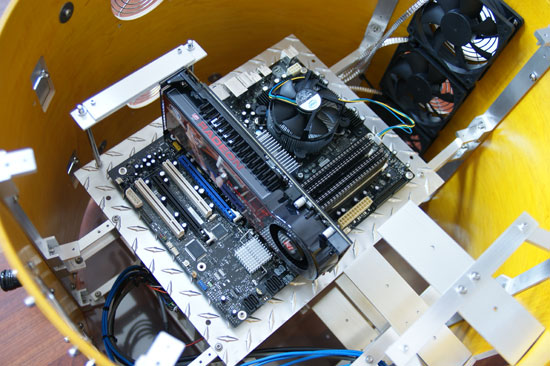
Installing the motherboard and add-in cards is simple enough, as is dropping the tray back into the system. I would actually recommend holding off on putting the tray back in until after installing the power supply and drives, as things are a little easier to reach this way.
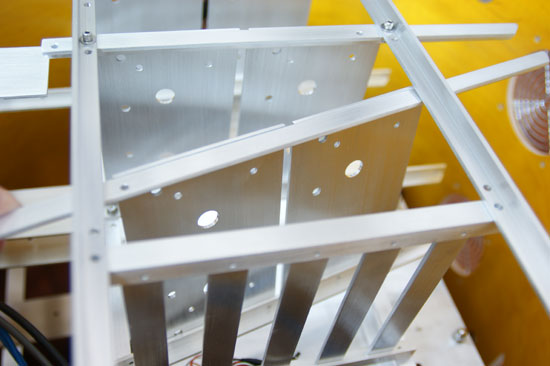
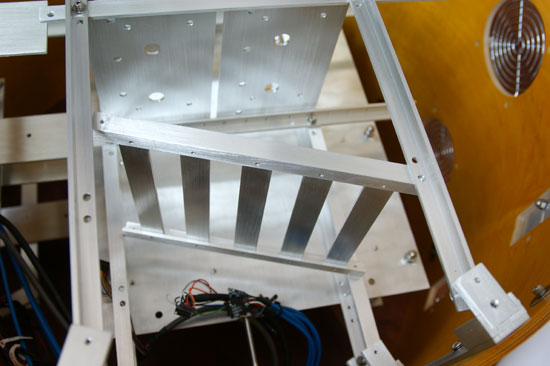
Turning over to the power supply, the instructions state that we may need to remove the lower hard drive mounting bracket in order to fit an oversized power supply. As we wanted to use our 1200W PCP&C PSU (which is definitely large), we did need to remove this hardware.
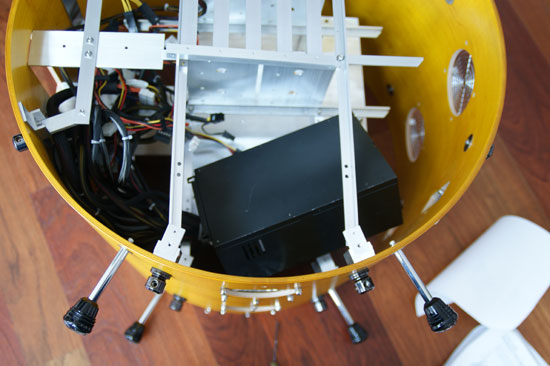
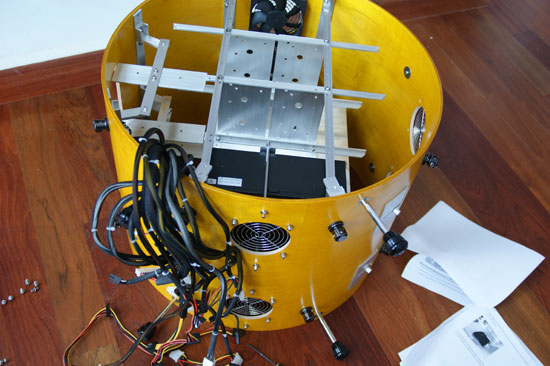
Even after this, it was a bit tricky to get the PSU to fit. If you are going with this case to build your prized enthusiast system with 3-way SLI or 4-way CrossFire, RAID arrays, and other goodies (with a matching power guzzler of a PSU), you might have to spend some time coaxing everything into place.

Optical drives install through the front. Standard drive bay covers likely will not work on this monster, and they will definitely mar the exterior. You can see we left one side open, which looks out of place on such a case. Since these things are custom, it's a good idea to only have Spotswood cut as many external drive bays as you need.
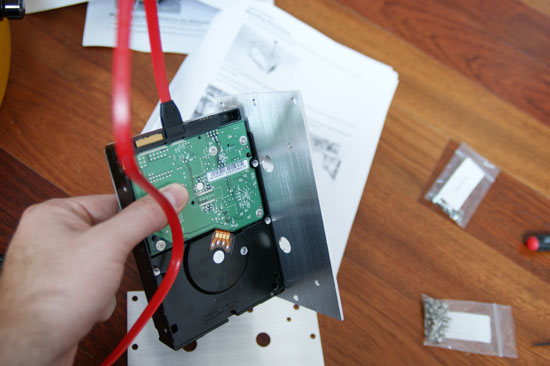

Mounting hard drives involves screwing them into plates and then screwing those plates into the rack.

Plugging everything in was not easy, even with the long cables on our PSU. Despite the fact that the PSU is basically mounted right behind the motherboard, the cables start at just about as far away as possible from where they need to go. We had to finesse our 8-pin EPS12V power connector around the back, and we fought for every millimeter.
Here is the full gallery of our build process.
















36 Comments
View All Comments
mediarx - Wednesday, August 27, 2008 - link
If you want to see some crazy designed cases hitting the shops next year check out :http://www.media-receive.co.uk/epages/es111379.sf/...">http://www.media-receive.co.uk/epages/e...h=/Shops...
bigboxes - Wednesday, August 27, 2008 - link
"Granted I don't use cases at all in my house, but even a standard monolith of a computer case wouldn't do much to impress."What's that supposed to mean? You don't use cases to house your pc components?
computerfarmer - Wednesday, August 27, 2008 - link
This looks like it could be used in the living room as part of a home entertainment system. Perhaps the new AMD 790GX/SB750 chipset motherboard. Looking forward to the review on the chipset.dawp - Wednesday, August 27, 2008 - link
Ya'll are missing the point of this case. it's for locations where a conventional case may not fit, looks wise. it'll fit in where a normal case would be out of place.That said, interesting, but for that size, I think it could have been better.
Davelo - Wednesday, August 27, 2008 - link
Huh? The only place this would fit better is on a soundstage and then some rocker will attempt to beat it with a stick!This thing is a goofy idea. Might as well buy an apple.
Clauzii - Wednesday, August 27, 2008 - link
"Oh, that was Your PC? Sorry mate!"Lars Ulrich (Metallica) after watching the inner stuff getting crashed to pieces :D
HOOfan 1 - Wednesday, August 27, 2008 - link
Yeah because a big bass drum fits into so many more decors than a conventional computer case.So what about the monitor, mouse and keyboard, how do those compliment that bass drum?
Polynikes - Wednesday, August 27, 2008 - link
Did you not even read the first page of the review? This case was purchased specifically to go into a room filled with musical equipment, including a drum set. A random bass drum off to the side with wires sticking out of it would look better than a beige computer case.HOOfan 1 - Wednesday, August 27, 2008 - link
I read it, I was replying to the person above who said the point of these specific cases was to fit into a place where a PC case might not look right. His respose was to those saying these cases looked ugly. Apparently this company only makes cases that look like drums...so that is rather esoteric, more so than an ordinary computer case.Since most people in this thread were refering specifically to the aesthetics of the drum case, and the poster I replied too was trying to defend the case by stating that it fits in aesthetically where a computer case does not, I am pointing out that a computer case will fit into more environments than a drum shaped case.
strikeback03 - Wednesday, August 27, 2008 - link
Could use an LCD TV mounted on the wall for a monitor, and have the keyboard/mouse (wireless obviously) stored somewhere out-of-sight when not in use.I don't mind HTPC/Shuttle style cases anywhere and I wouldn't go for a large bass drum either, but I can imagine them having somewhat more practical possibilities. For instance, if you have a single sub as part of your system, they could probably make a case that looks similar to go on the other side of the room. Someone mentioned a coffee table, I'd think that would be easy other than hiding the cable for whatever is used as a monitor.